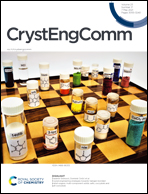Crystal engineering strategies towards halogen-bonded metal–organic multi-component solids: salts, cocrystals and salt cocrystals
Abstract
Over the past several decades, halogen bonding has become a standard ‘tool’ in supramolecular chemistry and particularly in crystal engineering. Traditionally, the study of halogen bonding has primarily been focused on organic materials, but lately there has been a constant increase in interest for halogen-bonded metal–organic materials. Numerous reports and reviews dealing with halogen bonding in single-component metal–organic solids and metallate salts have been published to date. In contrast, the design of multi-component crystals involving neutral metal–organic complexes and/or neutral halogen bond donors as building blocks has been much less explored. The purpose of this paper is to give an overview of the current advances in the preparation of halogen-bonded metal–organic multi-component solids, including salts, cocrystals comprising neutral constituents as well as cocrystals comprising ionic constituents. In doing so, we shall outline the general design strategies which can be employed in the design of such materials, and suggest possible directions for further research in this fascinating field.

- This article is part of the themed collections: CrystEngComm up-and-coming articles, 2021 Highlight article collection and Supramolecular & Polymorphism


 Please wait while we load your content...
Please wait while we load your content...